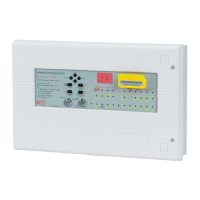EP203 AUTOMATIC EXTINGUISHER PANEL
Approved Document No. DFU0002032 Rev 4 • EP203 AUTOMATIC EXTINGUISHER PANEL INSTALLATION MANUAL • Page 39 of 45
Sys tem Faults
System faults are unique in that they do not automatically clear when rectified.
The LCD unit displays ‘System Fault’ and the System Fault yellow LED flashes when one,
or more of the following has occurred:
• There is a microprocessor “watchdog” fault
• The microprocessor’s site memory has been corrupted
• The microprocessor’s program memory has been corrupted
• The Main Control PCB is faulty
For a detailed description of what each fault is and suggested corrective action, see below:
Watc hdog faul t
Sy m p tom s : This type of system fault occurs when the panel’s microprocessor has failed
to operate correctly, e.g. due to excessive electrical interference, and the panel’s
“Watchdog” circuit has been unable to bring it back under control. A common symptom
of this is the panel’s controls locking-up.
Suggested action:
1. Press the panel’s Reset pushbutton and, if still in Access Level 3, the Escape
Access pushbutton. This should clear the fault. If the fault persists, the Main
Control PCB is faulty and must be replaced.
Si te memory cor rup t ion fa ul t
Sy m p tom s : This type of system fault occurs when site specific data retained in the
panel’s microprocessor is found to be corrupt.
Suggested actions :
1. Check all the site-specific data (delays, disablements, etc.) at authorised user and
engineering level.
2. If errors are found, reprogram the panel accordingly to clear the corruption.
3. If no errors are found, temporarily change some data e.g. Flooding Time. This
should clear the fault. If the fault persists, the memory is damaged and the Main
Control PCB must be replaced.
Program mem o ry cor ruption fault
Sy m p tom s : This type of system fault occurs when the microprocessor’s memory is found
to be corrupt.
Suggested actions :
1. Reset the panel and the fault will clear. Wait for 2 minutes
2. If the fault re-occurs then the memory is damaged and the Main Control PCB
must be replaced. If the fault does not re-occur, then there was a momentary
disturbance during the microprocessor’s self-checking routine and no further
action needs to be taken.
3. If the fault persists, the Main Control PCB is faulty and must be replaced.

